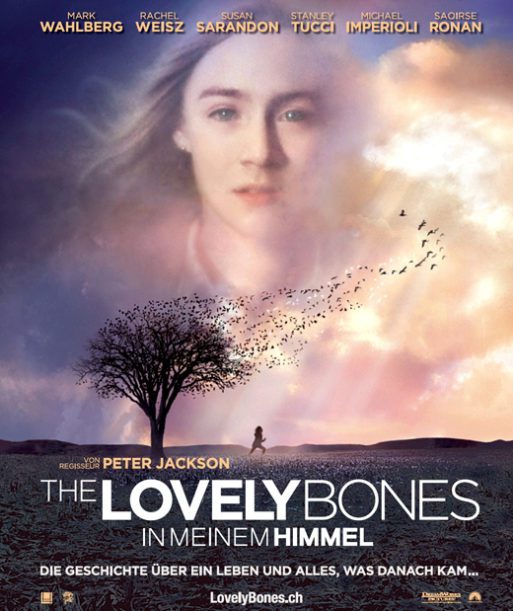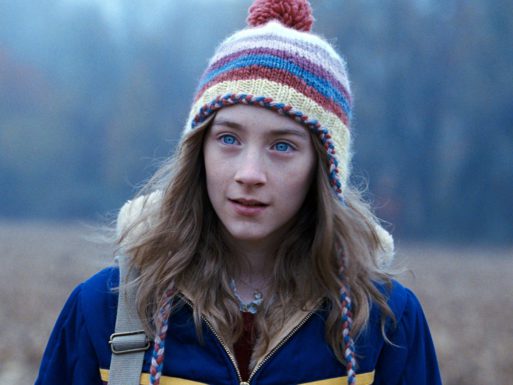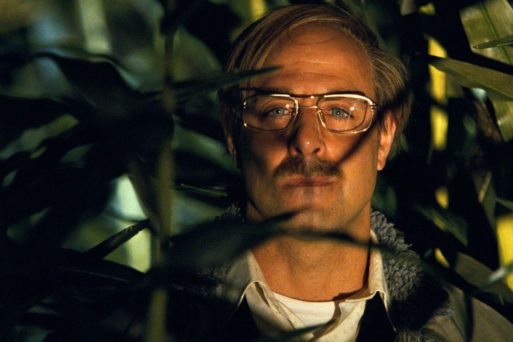 “The Lovely Bones” (2009) should have and could have been a good film. Co-written and directed by Peter Jackson, who’s best known for his wildly popular Tolkein adaptations, The Fellowship of the Ring (2001), The Two Towers (2002), and The Return of the King (2003), it’s based loosely on Alice Sebold’s novel of the same name. The story of a young girl who is brutally murdered and subsequently ”revisits” her grieving family from the afterlife, it promises to be a moving examination of the aftermath of tragedy and the devastation the murder of a child brings to everyone involved. (Not unlike the Netflix series, “The Killing,” which was one of the most honest portrayals of traumatic grief I’ve ever seen.) The fact that the murdered child, Suzie Salmon (Saoirse Ronan) watches the action from a purgatory-like fantasy world located somewhere between Heaven and Earth could have been an effective cinematic device to allow the viewer a window into the family’s grief. Sadly, the operative words in that sentence are “could have been.” What actually happens is an awkward and unsatisfying blend of overblown fantasy, silliness and superficiality that was sometimes torturous to watch.
“The Lovely Bones” (2009) should have and could have been a good film. Co-written and directed by Peter Jackson, who’s best known for his wildly popular Tolkein adaptations, The Fellowship of the Ring (2001), The Two Towers (2002), and The Return of the King (2003), it’s based loosely on Alice Sebold’s novel of the same name. The story of a young girl who is brutally murdered and subsequently ”revisits” her grieving family from the afterlife, it promises to be a moving examination of the aftermath of tragedy and the devastation the murder of a child brings to everyone involved. (Not unlike the Netflix series, “The Killing,” which was one of the most honest portrayals of traumatic grief I’ve ever seen.) The fact that the murdered child, Suzie Salmon (Saoirse Ronan) watches the action from a purgatory-like fantasy world located somewhere between Heaven and Earth could have been an effective cinematic device to allow the viewer a window into the family’s grief. Sadly, the operative words in that sentence are “could have been.” What actually happens is an awkward and unsatisfying blend of overblown fantasy, silliness and superficiality that was sometimes torturous to watch.

Suzie meets her killer in a cornfield, where her hat is later found.
Credit: Paramount/Dream/Works
To be fair, Suzie’s character is likable and real, and Ronan’s portrayal of her last moments and subsequent “trip” to the afterlife is quite good. In the aftermath of her murder, Suzie tumbles through what appears to be real-life scenarios, at one point calling out to her father as he searches the streets for her, only to discover that he can’t hear her screams. The scene in which she realizes what happened to her is pretty horrifying, and her acting there is flawless. But the plot quickly falls apart, in large part because Jackson seems more interested in portraying Suzie’s purgatory-like state with increasingly surreal special effects than in telling a story in a compelling way. Mark Walberg and Rachel Weisz, who play Suzie’s bereaved parents, Jack and Abigail, do a more-than passable job of portraying their grief. But Jackson’s preoccupation with Suzie’s celestial existence doesn’t give the characters room to grow.
It’s too bad, too, because there are some good performances in the film, made far less effective by inept writing and hollow premises with quasi-religious overtones. Susan Sarandon provides comic relief as Suzie’s pill-popping, chain smoking, booze-guzzling grandma, whom Suzie’s father inexplicably invites to stay with the family because his wife ”isn’t coping well.” Stanley Tucci plays the murderous Mr. Harley with suitably understated malice (he was nominated for an Oscar for the role.) And Rose McIver is convincing as Suzie’s little sister Lindsey, who all along is getting vibes that Mr. Harley is Suzie’s murderer. (Jack eventually gets the same idea, although it’s unclear how or why.)

Stanley Tucci was nominated for an Oscar for his portrayal of the serial killer in “The Lovely Bones.”
Credit: Paramount/DreamWorks
But the plot becomes less and less believable as the movie wears on. Abigail, after a fight with Suzie’s grandmother, takes off to pick grapes in a vineyard in California. Harley, feeling the need to kill again, begins stalking young lovers through nearby corn fields at night. Jack, who has reported his suspicions about Harley to the police but is told he needs proof, gets wind of this behavior and follows him with a baseball bat one night. But instead of catching Harley “in the act,” he winds up beaten to within an inch of his life–not by Harley, but by a teenage boy whose private time with his girlfriend he cut short. As he is recovering at home, his wife magically reappears, and they kiss and make up.
It’s all very disjointed and somehow emotionless, as if everyone involved is one step removed from the tragedy that started it all.

Suzie looks around in wonder as she begins to explore the afterlife.
Credit: Paramount/DreamWorks
But in the end, it wasn’t the implausible story line that ruined this film for me, but rather the underlying premise of Suzie’s idyllic afterlife. Perhaps there are viewers who felt heartened by the fact that, despite being murdered, cut into pieces and stuffed into a safe that’s eventually thrown into a sinkhole, she’s a happy, well-adjusted kid. Sure, she’s a little sad that she never got to kiss her teenage crush, but overall, being dead seems pretty okay by her. And when she finally gets to Heaven and meets Harley’s other victims, they all hug and laugh and are really, really happy to be where they are. None of them are angry or sad or even a little bit wistful about the lives they lost. It simply doesn’t make sense.
The murder of a young person is a horrific tragedy. In his telling of “The Lovely Bones” Jackson seems to want us to believe that being killed at 14 isn’t really all that bad because, “Hey, look at where you wind up!” Even if you believe in Heaven, that isn’t remotely true.
Watch the trailer for “The Lovely Bones” below.

 “The Lovely Bones” by Peter Jackson
“The Lovely Bones” by Peter Jackson


 National Donate Life Month Reminds Us To Give
National Donate Life Month Reminds Us To Give
 How Dare You Die Now!
How Dare You Die Now!
 Debating Medical Aid in Dying
Debating Medical Aid in Dying














